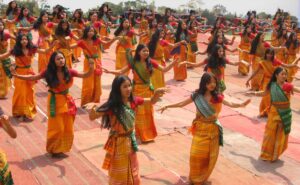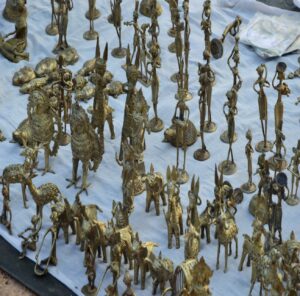5 Arenas Where Tribal India Shattered the Mainstream Ceiling
Whether it is the tribes’ ability to innovate, adapt, and create, they continue to use their skills to thrive in an ever-evolving world
The culture and practices of the tribes of India form a rich part of our history. Whether it is in the realm of arts, music, dance, handicrafts, or innovation, their way of life is one which is unique. However, it is true that they remain off the radar of mainstream India on most days.
But that has not stopped them from making a mark in mainstream India with their contributions to the economy, sports and much more! So, here are five areas where tribal India broke through that barrier!
The cultivation and export of natural products.
Many tribes were originally hunter-gatherer societies. As such, their knowledge of ancient herbs, plants and other natural products is tantamount to that of an expert.
These skills that were once a part of their tradition have now become a means for not only their livelihood but an active contribution to furthering India’s economic growth.
Members of Kattunayakan, an ancient tribe in Kerala, have been collecting and selling wild honey for years. Tribals in the Koraput region of Orissa have also adopted beekeeping to earn a livelihood. They cultivate natural honey, and this is widely sought after in both the domestic and global market. According to a report by Agriculture Processed Food Products Export Development Authority (APEDA) 38, 177.08 metric tonnes of honey, worth 705.87 crores was exported in 2015-2016.
Tribes that live near forest-fringed villages usually tend to cultivate organic food grains, and gather bamboo, ivory, timber, and fruits, which they sometimes make into natural products, for example, soaps!
- The sports stars who made India proud
Sports stars Baichung Bhutia and Mary Kom.
The tribes of India are known for their natural stamina and strength, which is a product of their lifestyle. As a result, many prominent sports figures hail from tribes across India. Mary Kom, a five-time world amateur boxing champion, and Olympic Medal winner hails from the Kom tribe in Manipur, and Baichung Bhutia, the first Indian to play professional football in England, comes from a tribe from Tinkitam in Sikkim.
At one point in time, Dilip Tirkey, who belonged to the Oraon tribe of Odisha, was a force to be reckoned with on the hockey field and was referred to as one of the toughest defenders to beat in the entire world. These are just a few of the many people of tribal origin who have excelled in the field of sports, and have made India proud with their achievements in the domain!
- Their centuries-old music and dance
Dance and music are a way of expression, and for India’s tribal communities, it has become an aspect which defines their culture. The Bagurumba is a dance which is said to represent the Bodo tribe’s strong connection to nature, while the women of the Kamar tribe perform a dance known as Tertali. This is an intricate dance where the performers sit on the floor and have several cymbals attached to their body, and a pot balanced on their head, and a sword between their teeth.
There are hundreds of folk dances that originated in the tribes of India, and the list is exhaustive!
Bagurumba, the dance of the Bodo tribe.
Many of them are still performed for festivals and celebrations today.
Tribal India has also stepped out of its indigenous tradition to make waves in other folk forms as well, as in the case of Padma-winner Teejan Bai. A member of the Pardhi tribe, in Chhattisgarh, Teejan is a world-renowned Pandavani exponent. This art form involves singing, playing various traditional instruments, and enacting scenes from the Mahabharata, and Teejan has been invited to other countries to perform, which has put her tribe on the global map!
Whether it is to express joy, entertain, or celebrate, the hundreds of folk dances that India’s tribes have given to the country has definitely added to India’s cultural repertoire.
- The coveted handicrafts—a significant source of income
Tribal handicrafts are coveted around the world, for the precision, and effort with which each piece is created.
Their age-old traditions have cultivated a generation of artisans who have honed their craft to contribute not only to the domestic market but India’s exports as well.
An array of the Dhokra technique. Source:
The Bhil and Bhilala tribes are known for their ragged dolls. While in the domestic market, a doll may fetch up to Rs 10,000, in foreign craft bazaars, their prices have been known to fetch a prize of Rs 50,000, depending on the size! The tribals of the Kalahandi district in Orissa craft good quality products out of wood, which have been exported to other countries, while the Dhokra Damar tribes of West Bengal and Odisha are the creators of Dhokra technique, which has been used to create metal artefacts. These artefacts are known for their simplicity, folk touch, and form.
If one travels to the Mayurbhanj region of Odisha, the tribes there create ropes made out of Sabai grass, which have been noted for their durability. The Adivasis of India have created all kinds of art, including paintings, metalwork, jewellery, bamboo craft, and woodwork!
In 2013-2014 exported handicrafts in India earned a total of $3304.9 million! Each year, handicrafts are exported to at least 100 countries around the world.
- Their knowledge of medicinal plants
Before chemical medicines reached India’s shores, there was the natural medicine that came from the land. Over 7500 species of plants can be used for medical purposes in India.
Today, several tribes across India, who live close to forests retain extensive knowledge of their use.
Tender bamboo shoots have been known to cure muscle pain. A plant known as “narinaranga” is used by the Kurichiar in a paste made to provide relief for sprains; and for the Sugali tribe of Andhra Pradesh, the garlic bulb is a remedy for fever. There are thousands of such natural remedies within
Many of us living in the modern world have begun to admire traditional remedies, and it is a known fact that tribal people have been practising these remedies since the time of their ancestors. This has now become a part of their livelihood, with many tribes cultivating plants as part of subsistence agriculture.
The people have lived off the land, and have given back just as much as they have taken. Their contributions to India’s culture have been unforgettable. Whether it is their ability to innovate, adapt, and create, they continue to use their skills to thrive in an ever-evolving world, staying true to themselves, while also reaching new heights in novel fields!




